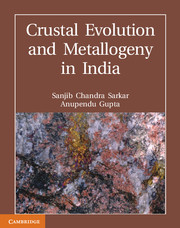Book contents
- Frontmatter
- Dedication
- Contents
- List of Figures
- List of Tables
- List of Plates
- Preface
- Chapter 1 Southern India
- Chapter 2 Central India
- Chapter 3 Eastern Ghat Belt
- Chapter 4 Eastern India
- Chapter 5 North-East India
- Chapter 6 Western India
- Chapter 7 The Himalaya
- Chapter 8 Crustal Evolution and Metallogeny in India: A Brief Review in the Context of the World Scenario
- References
- Index
- Plate Section
Chapter 4 - Eastern India
Published online by Cambridge University Press: 05 February 2014
- Frontmatter
- Dedication
- Contents
- List of Figures
- List of Tables
- List of Plates
- Preface
- Chapter 1 Southern India
- Chapter 2 Central India
- Chapter 3 Eastern Ghat Belt
- Chapter 4 Eastern India
- Chapter 5 North-East India
- Chapter 6 Western India
- Chapter 7 The Himalaya
- Chapter 8 Crustal Evolution and Metallogeny in India: A Brief Review in the Context of the World Scenario
- References
- Index
- Plate Section
Summary
Geology and Crustal Evolution
Introduction
The eastern segment of the Indian Precambrian shield preserves records of geological events spanning over Early Archean to Late Proterozoic time. There is a debate about the definition of the Eastern Indian craton. Should it comprise only the Archean basement rocks of South Singhbhum and some adjacent parts of Orissa and the banded iron formation (BIF)-bearing belts of supracrustal rocks flanking them? Or should it also include the physically contiguous and geologically related Proterozoic mobile belt of North Singhbhum and the Chhotanagpur Gneissic Complex (CGC), lying to the north of this belt. We, in the present context, define the area in its conventional sense, viz, from the Chhotanagpur Gneissic Complex in the north, upto the margin of Eastern Ghat granulite terrain in the south, and the eastern margin of the Mahanadi graben in the west to the last exposure of Precambrian rocks in the east. Considered in the context of crustal evolution of the region, these limitations should satisfy the definition of a craton (cf. Goodwin, 1996; Hoffman, 1988). However, the Archean granitic basement and the ancient supracrustal rocks of South Singhbhum–North Orissa may be considered to constitute the Archean cratonic nucleus (Fig.4.1.1).
- Type
- Chapter
- Information
- Crustal Evolution and Metallogeny in India , pp. 343 - 525Publisher: Cambridge University PressPrint publication year: 2012



